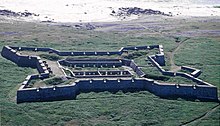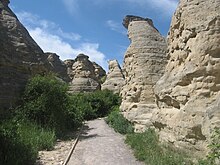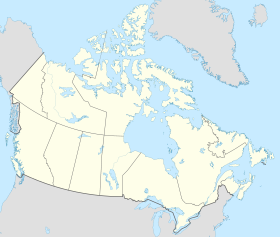National Historic Sites of Canada
National Historic Sites of Canada (
There are related federal designations for
History
Early developments


Emerging
Domestically, Lord Dufferin, the Governor General from 1872 to 1878, initiated some of the earliest, high-profile efforts to preserve Canada's historic sites. He was instrumental in stopping the demolition of the fortifications of Quebec City, and he was the first public official to call for the creation of a park on the lands next to Niagara Falls.[13][14]
The 1908 tricentennial of the founding of
In 1919,
Historic Sites and Monuments Board of Canada

On Harkin's recommendation, the government created the Advisory Board for Historic Site Preservation (later called the Historic Sites and Monuments Board of Canada) in 1919 in order to advise the Minister on a new program of National Historic Sites.
Due to a lack of resources, the HSMBC limited itself to recommending sites for designation, and the focus of the program was on commemoration rather than on preservation. Benjamin Sulte, a member of the HSMBC, wrote to Harkin in 1919 about the significant ruins at the Forges du Saint-Maurice, demonstrating his preference for the installation of a plaque over restoration: "All that can be done in our days is to clear away the heap of stones, in order to reach the foundation walls and plant a sign in the centre of the square thus uncovered."[21]
In the early years of the program, National Historic Sites were chosen to commemorate battles, important men, the fur trade and political events; the focus was on the "great men and events" credited with establishing the nation.
The following have served as members of the Historic Sites and Monuments Board of Canada:
| Name | Province | Year joined | Year left | Additional |
|---|---|---|---|---|
| E.A Cruikshank | Ontario | 1919 | 1939 | Board Chairman 1919–1939 |
| James Coyne | Ontario | 1919 | 1932 | |
| Frederic Howay | British Columbia | 1923 | 1944 | Board Chairman 1943–1944 |
| Fred Landon | Ontario | 1932 | 1958 | Board Chairman 1950–1958 |
| W.N. Sage | British Columbia | 1944 | 1959 | |
| Harry Walker | Ontario | 1955 | 1959 | |
| Donald Creighton | Ontario | 1958 | 1972 | |
| A.R.M. Lower | Ontario | 1959 | 1961 | |
| Margaret Ormsby | British Columbia | 1960 | 1967 | |
| James J. Talman | Ontario | 1961 | 1973 | |
| James Nesbitt | British Columbia | 1967 | 1971 | |
| Margaret Prang | British Columbia | 1971 | 1979 | |
| J.M.S Careless | Ontario | 1972 | 1985 | Board Chairman 1981–1985 |
| B. Napier Simpson | Ontario | 1973 | 1978 | |
| Charles Humphries | British Columbia | 1979 | – | |
| Edward Storey | Ontario | 1981 | 1987 | |
Thomas H.B Symons
|
Ontario | 1986 | – | Board Chairman 1986– |
| John H. White | Ontario | 1988 | – |
Evolution of the program

As time passed and the system grew, the scope of the program and the nature of the designations evolved. By the 1930s, the focus of the heritage movement in Canada had shifted from commemoration to preservation and development. The change was most marked in Ontario, where the
In 1943, the interim chairman of the HSMBC, Frederic William Howay, urged his fellow Board members to consider a broader range of designations, and to correct the geographic and thematic imbalance in the designations. In particular, Howay encouraged the HSMBC to pay more attention to economic, social and cultural history, and he urged a moratorium on additional designations related to the War of 1812.[31][32] In 1951, the Royal Commission on National Development in the Arts, Letters and Sciences highlighted the imbalances of the National Historic Sites program, urging a more ambitious program with more attention paid to architectural preservation. In 1955, the Historic Sites and Monuments Act was amended to allow the designation of buildings due to their age or design, resulting in a new focus on the designation of Canada's built heritage.[33][34] The 1950s also marked the beginning of the "big project" era, which reached its apogee in the 1960s, in which the federal government invested significant funds in the restoration and reconstruction of high-profile National Historic Sites such as the Halifax Citadel, the Fortress of Louisbourg, the fortifications of Quebec City and the historic core of Dawson City.[35]
The 1970s marked the start of a new shift in the nature of the designations. Of the 473 National Historic Sites designated between 1971 and 1993, the formerly dominant category of political-military events represented only 12 percent of the new designations, with the "Battle of..."-type commemorations being overtaken by sites associated with federal politics. The largest group of designations (43 percent) pertained to historic buildings.
Changes were not limited to new designations, as the interpretation of many existing National Historic Sites did not remain static and evolved over time. For example, the commemoration of National Historic Sites on the
Designations

National Historic Sites are organized according to five broad themes: Peopling the Land, Governing Canada, Developing Economies, Building Social and Community Life, and Expressing Intellectual and Cultural Life.[40] To be commemorated, a site must meet at least one of the following criteria:
- illustrate an exceptional creative achievement in concept and design, technology or planning, or a significant stage in the development of Canada;
- illustrate or symbolize, in whole or in part, a cultural tradition, a way of life or ideas important to the development of Canada;
- be explicitly and meaningfully associated or identified with persons who are deemed to be of national historic significance; or
- be explicitly and meaningfully associated or identified with events that are deemed to be of national historic significance.[41]
Designation as a National Historic Site provides no legal protection for the historic elements of a site.[42] However, historic sites may be designated at more than one level (national, provincial and municipal),[15] and designations at other levels may carry with them some legal protections.
Most National Historic Sites are marked by a federal plaque bearing
Lists of National Historic Sites by location
See also
- Canadian Register of Historic Places
- National symbols of Canada
- Royal monuments in Canada
- Seven Wonders of Canada
- List of World Heritage Sites in Canada
References
- ^ Historic Sites & Monuments Board of Canada. "About the Historic Sites and Monuments Board of Canada – Duties". Archived from the original on October 6, 2012. Retrieved August 23, 2010.
- ^ Historic Sites & Monuments Board of Canada. "Criteria, General Guidelines and Specific Guidelines – PLACES". Archived from the original on October 6, 2012. Retrieved August 23, 2010.
- ^ Parks Canada. "National historic sites". Canada.ca. Archived from the original on 5 July 2023. Retrieved 5 July 2023.
- ^ Parks Canada. "National Historic Sites of Canada – administered by Parks Canada". Archived from the original on May 29, 2015. Retrieved September 22, 2016.
- ^ "National Historic Sites of Canada System Plan – Introduction". Parks Canada. 2000. Archived from the original on October 6, 2012. Retrieved August 23, 2010.
- ^ "National Historic Sites of Canada System Plan – Persons of National Historic Significance, Events of National Historic Significance". Parks Canada. 2000. Archived from the original on June 5, 2011. Retrieved August 23, 2010.
- ^ Welland Canal National Historic Event Archived 2017-11-13 at the Wayback Machine, Parks Canada, 2012.
- ^ Prince of Wales Fort. Directory of Federal Heritage Designations. Parks Canada. Retrieved 12 August 2012.
- ^ a b c d Historic Sites & Monuments Board of Canada. "About the Historic Sites and Monuments Board of Canada – History of the Board". Archived from the original on February 7, 2013. Retrieved August 23, 2010.
- ^ "De Victor Hugo à lord Dufferin". Patrimoine: Historique de la Loi sur les biens culturels. Ministère de la Culture, des Communications et de la Condition féminine. Archived from the original on 3 March 2012. Retrieved 15 April 2012.
- ^ Rapport d'information n°599, Au service d'une politique nationale du patrimoine : le rôle incontournable du Centre des monuments nationaux, Françoise Férat, 15 April 2012
- ^ The National Parks: Shaping the System Archived 2015-03-23 at the Wayback Machine, U.S. National Park Service, 2005, p. 41. Battlefields would not be administered by the National Park Service, however, until 1933.
- ^ .
- ^ "History". Niagara Parks. Archived from the original on 3 April 2012. Retrieved 15 April 2012.
- ^ Canadian Encyclopedia. Archivedfrom the original on June 20, 2015. Retrieved August 23, 2010.
- ISBN 0-7735-0713-2.
- ^ Negotiating the Past: pp. 30, 45
- ^ Fortress of Louisbourg National Historic Site of Canada. Canadian Register of Historic Places.
- ISBN 0-920064-58-2.
- ISBN 0-662-50533-6.
- ^ Negotiating the Past: pp. 33–5, 51
- ^ a b Parks Canada. "National Historic Sites of Canada System Plan – Enhancing the System". Archived from the original on October 6, 2012. Retrieved August 23, 2010.
- ^ Negotiating the Past: p. 6
- ^ The Place of History: p. 57
- ^ Negotiating the Past: pp. 45, 48–9, 60, 75 and 130
- doi:10.7202/016105ar.
- ^ Áísínai'pi National Historic Site of Canada. Canadian Register of Historic Places.
- ^ Westmount District. Directory of Federal Heritage Designations. Parks Canada. Retrieved 25 April 2012.
- ^ "National Historic Designations, Historic Communities (Backgrounder)". News Releases and Backgrounders. Parks Canada. Archived from the original on 17 October 2013. Retrieved 5 February 2012.
- ^ Negotiating the Past: pp. 101–3, 105, 109
- ^ Negotiating the Past: p. 130
- ^ a b Allan, McCullough (2002). "Parks Canada and the 1885 Rebellion/Uprising/Resistance". Prairie Forum. 27 (2): 161–198.
- ^ The Place of History: pp. 333–4
- ^ a b Recognizing Canadian History
- ^ Negotiating the Past: p. 170
- ^ Osborne, Brian S. (2001). "Landscapes, memory, monuments, and commemoration: putting identity in its place". Canadian Ethnic Studies. 33 (3): 39–77.
- ^ "Backgrounder". Signing of Memorandum of Understanding for Permanent Protection of Sahoyúé §ehdacho National Historic Site of Canada. Parks Canada. 11 March 2007. Archived from the original on 12 October 2013. Retrieved 11 October 2013.
- ^ National Historic Sites Policy. Ottawa: Indian and Northern Affairs – Parks Canada. 1972.
- ^ The Place of History: p. 334
- ^ Parks Canada. "National Historic Sites of Canada – Introduction". Archived from the original on February 18, 2011. Retrieved August 23, 2010.
- ^ Parks Canada. "National Historic Sites of Canada – System Plan". Archived from the original on October 6, 2012. Retrieved August 23, 2010.
- ^ Swinnerton, Guy S. & Buggey, Susan. "Protected Landscapes in Canada: Current Practice and Future Significance" (PDF). The George Wright Forum. George Wright Society. Archived (PDF) from the original on September 28, 2010. Retrieved August 23, 2010.
- ^ Parks Canada. "National Historic Sites of Canada System Plan – Enhancing the System". Archived from the original on October 6, 2012. Retrieved August 23, 2010.
- ^ Historic Sites & Monuments Board of Canada. "National Commemorative Plaques – Plaque Models". Archived from the original on October 6, 2012. Retrieved August 23, 2010.
Further reading
- Campbell, Claire Elizabeth. Nature, Place, and Story: Rethinking Historic Sites in Canada. McGill-Queen's University Press, 2017.
External links
- National Historic Sites of Canada – Parks Canada
- Historic places – Administered by Parks Canada


































